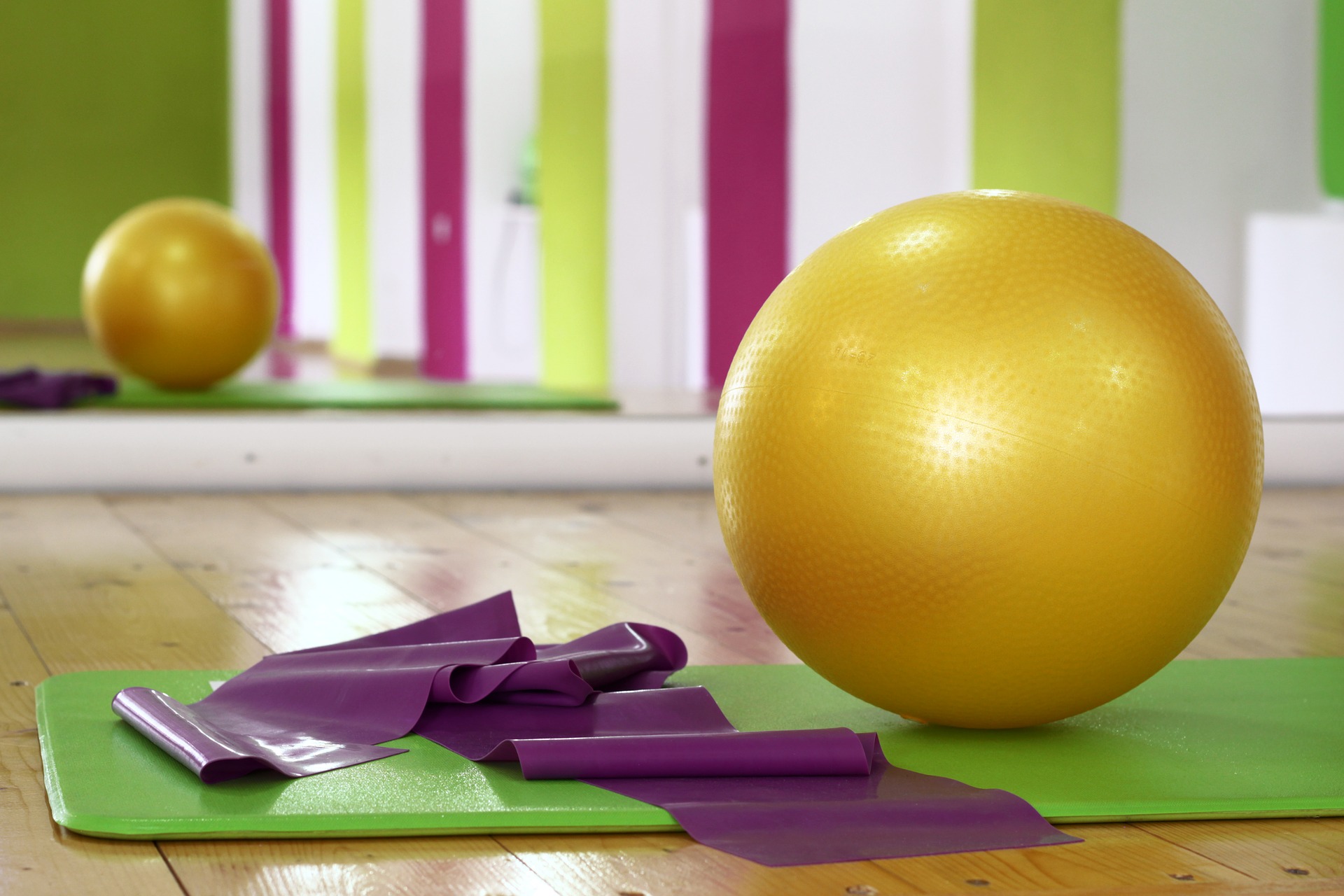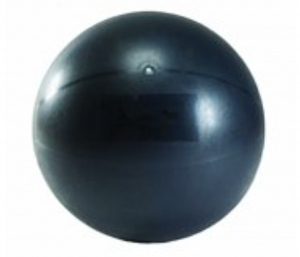
If you’ve been to any local commercial gym (or rehab facility) lately, you’ve probably seen a few of those big bouncy balls lying in the corner.
That, my friends, is a Swiss ball.
Simply put, the Swiss ball is one of the most versatile and portable pieces of exercise equipment on the planet.
The genius is in it’s simplicity- it’s just a giant ball.
But what it offers is endless variation to your workout.
It’s also affordable and can easily fit into any home gym, making them an easy addition to gyms with limited budgets or space restrictions.
If the Swiss ball is not already a part of your home gym, I encourage you to read on and see what you’re missing.
Swiss balls are great for core strengthening because they add an extra level of instability to any exercise you’re doing, forcing your core to work harder. But they can’t also be used for stretching and mobility work.
What is the “Swiss ball”?
Swiss ball, stability ball, core ball, exercise ball, therapy ball, fitness ball… the list goes on.
All names refer to the same product: an inflatable ball that comes in different sizes, designed for exercise.
Why is it called a “Swiss” ball you may ask?
Good question.
It got its name because it was first used by physical therapists and chiropractors in Switzerland in the 1960’s.
Later on, through educational seminars, it was introduced to the United States in the 1980’s.
Although it was first designed for rehab purposes, athletic trainers and coaches soon discovered the power of the Swiss ball and started using it to train their athletes and clients.
Check out a more thorough history here if you like.
These days, there are many different brands of “Swiss ball” coming from many different companies.
Swissball.com claims to be the “original” Swiss ball, and they say you can tell their product from a competitor’s by the swissball.com printing around the valve.
Theragear is the company producing them as well as many other types of fitness balls and equipment.
As a physical therapist, I use the term Swiss ball generically to describe any brand of stability ball.
Are the balls theragear produces any nicer than another companies? Not necessarily.
There are some cheaper models that work great too, so don’t feel like you have to necessarily spend more.
That said, Theragear does offer a “Swiss Ball Pro” that is a little heavier duty for larger individuals, with a higher burst proof weight of 500 pounds.
They recommend getting the Pro model if your body weight is near of greater than 300lb.
Benefits Of The Swiss Ball
Core stability!
That really is what this ball is all about – it provides an unstable surface to exercise on, thus forcing your core to activate in order to stabilize your body.
Pretty clever right?
Let’s look at an example.
Let’s take a common exercise- shoulder dumbbell press.
This exercise has many variations, but for this example let’s say that we are seated in a chair with a back, pressing 2 dumbbells overhead.
Great exercise for the shoulders, but when we do this exercise sitting on a standard seat, the seat is stable…that is, it doesn’t move.
Since the seat is providing the stability, our core muscles don’t have to work as hard to stabilize our trunk.
If we do the same exercise sitting on a seat that IS NOT STABLE, perhaps a Swiss ball, then our core muscles are going to have to provide that stability in order for our shoulders to be able to press that resistance over head.
One way or another, the core has to be stable in order for our arms or legs to function properly during exercise.
The same principle can be applied to foam pads, BOSU balls, or any type of balance apparatus you stand on.
The great thing about the Swiss balls is that they are big enough to sit on but you can also use them to support arms or legs for a truly unlimited number of exercises.
With the use of a Swiss ball, you can instantly make any exercise more difficult (as well as entertaining).
You are also basically turning any upper or lower body exercise into a core exercise as well, which is never a bad thing.

Using A Swiss Ball
We mentioned a little earlier about using a Swiss ball to switch up any seated exercise and make it more taxing on your core.
Here I want to mention a few other uses for this versatile piece of equipment:
- Seating- many desk workers are opting for a Swiss ball instead of a desk chair to improve core strength while they work.
- Balance- exercises can be performed sitting, kneeling, or even standing (if you are truly gifted) to improve balance and coordination.
- Flexibility- the ball can assist with stretching to improve muscle flexibility. Similar to a yoga block, you can use it to help position limbs during stretching, also great for stretching your abdominals and back.
- Core Stability- I know I keep repeating this, but the Swiss ball can really help you improve overall core strength which will improve performance in many other areas and reduce chance of back injury.
What Size Do I Need?
These exercise balls are sized primarily on your height and they typically come in 4-5 sizes: 45cm, 55cm, 65cm, 75cm and 85cm.
Check out the following table to see what size ball is best suited for your height:
| User Height | Swiss Ball Size |
| 4’10” and under | 45 cm |
| 4’8″ – 5’5″ | 55 cm |
| 5’6″ – 6′ | 65 cm |
| 6′ – 6’5″ | 75 cm |
| 6’5″ and over | 85 cm |
These are general guidelines, so some folks may prefer a little larger or smaller depending on use.
Personally, I like a ball that puts my hips and knees at about 90 deg when sitting on it.
I’m 6’1″ and the 65cm ball works pretty well.
When in doubt, I’d buy the larger size…you can always under inflate to get your desired position.
A Few Examples of Killer Core Exercises
If you’re not sold on the Swiss ball yet and need a few examples of some serious core exercises, don’t worry, I got ya covered.
A few of my favorites include:
- Standard push up with feet elevated on Swiss ball
- Plank with feet elevated on Swiss ball
- Plank pike
- Crunch while sitting on ball with feet elevated
- Standard crunch while sitting on ball
Do I Need One In My Gym?

Short answer…yes, you do.
Long answer…yes, if you want to add a durable, affordable, versatile piece of equipment that takes up little space and can give you an unlimited number of exercise variations.
If you can’t tell, I like my Swiss ball!
My history with the ball started when I was working as a therapist in an outpatient clinic.
We used the Swiss ball daily for core strengthening exercises, primarily for patients with back pain.
From there, I started using the ball off and on at the commercial gym I was going to – I would use it primarily for crunches or pikes.
When I started working out at home in my own gym, it was one of the first pieces of equipment I purchased.
I still use it some for planks and pikes, the occasional set of crunches… but now I like to use it more as a bench or seat while performing resistance exercises.
Anytime I’m feeling bored or want to switch up my routine easily, I just switch out my bench for the Swiss ball.
Shoulder presses, bench presses, concentration curls, tricep extensions…really anything you would do sitting can instantly become more difficult by performing on a Swiss ball.
Keep in mind though, you will have to reduce your weight a little when you switch over. The increased demand on your core will likely reduce your ability to lift as much weight…but that’s a good thing.
The Swiss ball forces your core to work hard, but will also force all the other stabilizing muscles to work harder as well.
For example, if you doing a chest press or shoulder press, the rotator cuff and scapular stabilizers will have to work a lot harder as well.
Anytime you are working more muscles at the same time, it’s a good thing!
Overall, I highly recommend the Swiss ball product.
I’ve been using it for years, but I did want to mention that many of the cheaper brands are still pretty good.
The original Swiss balls are great, but I purchased a cheaper version for my home. I’ve been using a Dynapro for many years now and it’s still going strong.
I hope this was educational and inspired you to start using a Swiss ball in your routine if you aren’t already.
If you have any questions, comments, or would like to share some of your favorite Swiss ball exercise, leave a comment below and I’ll get back to you shortly.



Very interesting article! I did not think the Swiss ball was such an essential part of working out but thank you for enlightening me to all the benefits! I will definitely consider getting one for myself. I like working out at home and I like that this is so portable.
Hi Jade, thanks for reading. Yea, if you enjoy working out at home this is a great addition. Super portable and very versatile.
These things are super versatile.
I know people who have them in the office as a chair for short spells to prevent back trouble.
I recently used one of these in the gym and it involved throwing it against the wall and catching it. If that was too easy, make a 360° turn between throwing and catching.
But the best part about these is to show how pressure changes sound. Basically, you sit on it and fart – the increased pressure in the ball (because you’re sitting on it) changes the sound to a funny sort of quacking sound – maybe not for the ladies …
Ha, thanks for bringing up an additional benefit of the Swiss ball! I like the exercise you mentioned about throwing the ball up against a wall, that idea opens up a whole other level of exercise options. Thanks for reading.